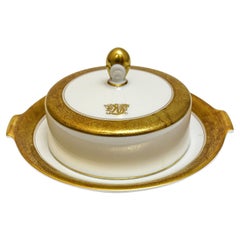Rosenthal Aida
Recent Sales
20th Century Serving Bowls
Porcelain
Rosenthal for sale on 1stDibs
While the Rosenthal Porcelain Factory grew from humble decorating roots — as many pottery companies do — it eventually built a list of universally revered designer and artist partners that included Andy Warhol and Salvador Dalí. And after securing an enviable position as a top manufacturer of serveware and dominating the porcelain and bone china markets, Rosenthal expanded into furniture production, working with influential designers Verner Panton, Luigi Colani and Günther Ferdinand Ris and Herbert Selldorf.
German-born Jewish businessman Philipp Rosenthal founded the company in 1879 in Bavaria. It began as his modest workshop where he painted porcelain and encountered success with porcelain ashtrays. Rosenthal hired the best designers and clay modelers he could find. Adolf Oppel designed figurative Art Nouveau pieces, while Eleonore (Lore) Friedrich-Gronau produced decorative objects, namely her graceful porcelain dancer figurines, for the company.
Dinnerware, though, would be a Rosenthal mainstay. Between 1904 and 1910, Rosenthal produced its renowned dinnerware lines such as Donatello, Darmstadt and Isolde. These were introduced as unornamented white pieces — only later were they given their underglaze designs.
Rosenthal founder Philipp, a Catholic of Jewish ancestry, resigned in 1934 as the company’s president due to pressures owing to discriminatory German laws that took shape during the rise of the Nazi regime. Rosenthal died in 1937, and the family fled to America. The company would not regain its footing until 1950 when Rosenthal’s son, Philip, joined the firm and, in 1958, became chairman and dubbed Germany’s “China King.” At its peak, the company had 10,000 employees.
In the 1950s, Rosenthal’s modernist dinnerware was a significant part of the brand’s offerings, and by 1961 they introduced the famed Rosenthal Studio Line. Although furniture designers and ceramicists would lead the list of individuals working with Rosenthal — among them Tapio Wirkkala, Max Weber and Lisa Larson — the company eventually reached out to fine artists, not only Dalí and Warhol but Sandro Chia and Kenny Scharf. Rosenthal also collaborated with fashion designers Gianni Versace and Donatella Versace.
In a daring move in 1972, the company diversified into furniture, collaborating with some of the giants of mid-century modern design. The revolutionary Sunball chair, an icon of Space Age seating crafted by Selldorf and Ris, was among Rosenthal’s stellar successes in this venture.
On 1stDibs, find vintage Rosenthal ceramics, porcelain, tableware, seating and more.
Finding the Right Bowls for You
Vintage, new and antique serving bowls are popular with collectors as well as cooks. While some serving bowls are merely decorative items, others are both eye-catching and functional.
The design and material of a bowl will vary depending on the period and location where it was made. Antique Chinese serving bowls are often exquisitely painted and made from fine porcelain. Colonial American wooden bowls are practical and elegant, able to hold brightly colored fruit or act as a serving dish at a family meal.
Along with wood, stone, metal and porcelain, there are also glass serving bowls. The most notable are made from Murano glass, named for the Murano Island in Venice where many of the world’s most famous glass objects have been produced. Glass serving bowls from the 19th through the mid-20th century are especially popular with collectors. Pieces from this era range from simple to ornate, frequently featuring gold or painted embellishments.
The styles of these bowls include art glass, which dates to the mid-19th century, and colorful carnival glass, which was introduced in the early 20th century. Carnival glass serving bowls were more affordable so they were used widely in homes. Depression glass, an iteration of glassware that was inexpensively mass-produced when people didn’t have much money to spend on decor during the 1920s and ’30s, featured bright colors. Milk glass, which had its heyday in the late 19th century, adds a touch of elegance to any table or display.
Antique and vintage serving bowls are desirable for their style, patterns and range of textures they can help introduce to a space. They are also prized for their rich history. Browse antique and vintage serving bowls on 1stDibs today.
